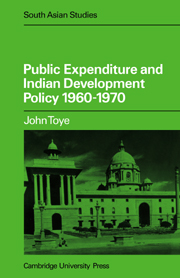Book contents
- Frontmatter
- Contents
- List of Tables
- Preface
- List of Abbreviations
- Introduction
- PART ONE GENERAL
- PART TWO EMPIRICAL EVIDENCE
- PART THREE CONCLUSIONS
- APPENDICES
- A Checklist of state-produced economic reclassifications
- B The calculation of expenditure centralization ratios from data on a national accounts basis
- C Problems arising in the preparation of statewise constant price expenditure series
- List of works cited
- Index
B - The calculation of expenditure centralization ratios from data on a national accounts basis
from APPENDICES
Published online by Cambridge University Press: 09 January 2010
- Frontmatter
- Contents
- List of Tables
- Preface
- List of Abbreviations
- Introduction
- PART ONE GENERAL
- PART TWO EMPIRICAL EVIDENCE
- PART THREE CONCLUSIONS
- APPENDICES
- A Checklist of state-produced economic reclassifications
- B The calculation of expenditure centralization ratios from data on a national accounts basis
- C Problems arising in the preparation of statewise constant price expenditure series
- List of works cited
- Index
Summary
In Table 6.2 the degree of centralization of government expenditure was calculated from data reclassified by the Indian C.S.O. on a national accounts basis. Appendix B considers whether there are valid objections to this.
The national accounts approach has been described as one designed 'to show the outlay actually made by each [level of] government for goods and services and transfer payments regardless of the source of funds'. Thus all transfers between levels of government, e.g. central grants to states, or state grants to municipalities, are shown once only. They are shown as part of the expenditure of the receiving government. This implies that the states' measured share in total expenditure will be higher on a national accounts basis than on any other. If these inter-level transfers are counted twice, once as the expenditure of the receiving government and once as the expenditure of the donor government (which is what Reddy seems to have done) the states' measured share will obviously be reduced. This is indicated by a comparison of the figure for 1968 in Table 6.1 (using Reddy's statistics) which is 50.3 per cent with the figure for 1968/69 in Table 6.2, which is 56 percent. Counting inter-level transfers once, but as the expenditure of the donor government would reduce the states' share even further, assuming that states always receive more in such transfers than they pass down to local authorities.
- Type
- Chapter
- Information
- Public Expenditure and Indian Development Policy 1960–70 , pp. 249 - 252Publisher: Cambridge University PressPrint publication year: 1981



